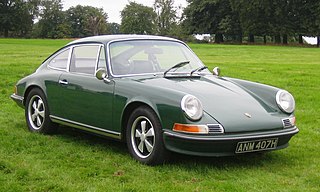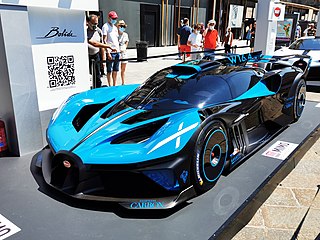
The Lotus Elise is a two-seat, rear-wheel drive, mid-engined roadster conceived in early 1994 and released in September 1996 by the British manufacturer Lotus Cars. The Elise has a fibreglass body shell atop its bonded extruded aluminium chassis that provides a rigid platform for the suspension, while keeping weight and production costs to a minimum. It is capable of speeds up to 240 km/h (150 mph). The Elise was named after Elisa Artioli, the granddaughter of Romano Artioli who was chairman of Lotus and Bugatti at the time of the car's launch.

The Peugeot 504 is a mid-size, front-engine, rear-wheel-drive automobile manufactured and marketed by Peugeot from 1968 to 1983 over a single generation, primarily in four-door sedan and wagon configurations – but also as twin two-door coupé and cabriolet configurations as well as pickup truck variants.

The Koenigsegg CC8S is a mid-engine sports car produced by the Swedish automobile manufacturer Koenigsegg. It was the company's first production automobile and the first production car to use the company's trademark dihedral synchro-helix actuation doors. At its introduction, it won several awards, including the Guinness World Record for the Most Powerful Production Engine and design awards from both Red Dot in Germany and Utmärkt Svensk Form in Sweden.

The Audi A2 (internally designated Typ 8Z) is a compact MPV-styled supermini car, with a five-door hatchback body style and four or five seats, produced by the German manufacturer Audi from November 1999 (for the 2000 model year) to August 2005. Based on the Audi Al2 concept car first shown at the Frankfurt Motor Show in 1997, the A2 was notable for being constructed from aluminium, which in combination with its efficient engines, made it an extremely economical car on fuel.

The Porsche 964 is the company's internal name for the Porsche 911 manufactured and sold between 1989 and 1994. Designed by Benjamin Dimson through January 1986, it featured significant styling revisions over previous 911 models, most prominently the more integrated bumpers. It was the first car to be offered with Porsche's Tiptronic automatic transmission and all wheel drive as options.

The Volkswagen XL1 is a two-person limited production diesel-powered plug-in hybrid produced by Volkswagen. The XL1 car was designed to be able to travel 100 km on 1 litre of diesel, while being both roadworthy and practical. To achieve such economy, it was produced with lightweight materials, a streamlined body and an engine and transmission designed and tuned for economy. The concept car was modified first in 2009 as the L1 and again in 2011 as the XL1.

The Lotus Exige is a British two-door, two-seat sports car made by Lotus Cars since 2000. Originally a more-hardcore coupé version of the Lotus Elise roadster, since the Series 3 the Exige has been the larger-engined model of the family - using a V6 engine in place of the Elise's straight-four with convertible versions of both available.

The Audi Coupé was a liftback coupé version of the Audi 80, first shown in 1980. The bodywork was shared with the Audi Quattro. The second generation Coupé arrived in late 1988 and was based on the B3 Audi 80, albeit with a different suspension. The Coupé remained in production until the end of 1996 and spawned the Audi S2 series of sports versions. A convertible model arrived in 1991, called simply the Cabriolet, and remained in production until 2000.

The Alfa Romeo GTA is a coupé automobile manufactured by the Italian manufacturer Alfa Romeo from 1965 to 1971. It was made for racing (Corsa) and road use (Stradale).

The Porsche 911 GT2 is a high-performance, track-focused sports car built by the German automobile manufacturer Porsche from 1993 to 2009, and then since 2010 as the GT2 RS. It is based on the 911 Turbo, and uses a similar twin-turbocharged engine, but features numerous upgrades, including engine enhancements, larger brakes, and stiffer suspension calibration. The GT2 is significantly lighter than the Turbo due to its use of rear-wheel-drive instead of all-wheel-drive system and the reduction or removal of interior components. As a result, the GT2 is the most expensive and fastest model among the 911 lineup.

The Volvo D5 is a type of turbocharged diesel engine developed by Volvo Cars for use in its passenger cars. The D5 engine is based on the Volvo Modular diesel engine. The D5 displaces 2.4 liters; a smaller series of two-litre engines were developed in 2010 and marketed as the Volvo D3 and D4.

The Mercedes-Benz C112 was an experimental mid-engine concept car built in 1991 by German automobile manufacturer Mercedes-Benz as a test bed, similar to the later versions of the C111. Despite using the same chassis code, it was not related to the W112 series of limousines and coupes of the 1960s. The C112 was intended to be the road-legal counterpart of the Sauber-built C11 Group C prototype race car developed for the 1990 World Sports-Prototype Championship.

The Lotus Evora is a sports car produced by British car manufacturer Lotus. The car, which was developed under the project name Project Eagle, was launched on 22 July 2008 at the British International Motor Show. The Evora S was launched in 2010 with a supercharged 3.5-litre V6. A facelifted and more powerful Evora 400 model was unveiled at the 2015 Geneva Motor Show, followed by another more powerful variant, the Evora GT430, which was unveiled in 2017.

The original Porsche 911 is a luxury sports car made by Porsche AG of Stuttgart, Germany. A prototype of the famous, distinctive, and durable design was shown to the public in autumn 1963. Production began in September 1964 and continued through 1989. It was succeeded by a modified version, internally referred to as Porsche 964 but still sold as Porsche 911, as are current models.

EcoBoost is a series of turbocharged, direct-injection gasoline engines produced by Ford and originally co-developed by FEV Inc.. EcoBoost engines are designed to deliver power and torque consistent with those of larger-displacement naturally aspirated engines, while achieving about 30% better fuel efficiency and 15% fewer greenhouse emissions, according to Ford. The manufacturer sees the EcoBoost technology as less costly and more versatile than further developing or expanding the use of hybrid and diesel engine technologies. EcoBoost engines are broadly available across the Ford vehicle lineup.

The Noble M600 is a handbuilt British sports car manufactured by low volume automobile manufacturer Noble Automotive in Leicestershire. Construction of the car is of stainless steel and carbon fibre. The car uses a twin-turbocharged Volvo/Yamaha V8 engine.

The second generation of the Subaru Impreza compact car was introduced in 2000 and manufactured up to 2007 by Subaru in Ota, Gunma, Japan, in both sedan and five-door wagon bodystyles, as well as two intermediate facelifts throughout its lifespan.

The Porsche 911 is a two-door 2+2 high performance rear-engined sports car introduced in September 1964 by Porsche AG of Stuttgart, Germany. It has a rear-mounted flat-six engine and originally a torsion bar suspension. The car has been continuously enhanced through the years but the basic concept has remained unchanged. The engines were air-cooled until the introduction of the 996 series in 1998.

The Polestar 1 is a 2-door plug-in hybrid sports car marketed by Polestar, a brand of Volvo Cars. It was the first car produced by the company since becoming an independent car manufacturer in June 2017. Based on Volvo's Concept Coupé from 2013, the Polestar 1 is built on the Volvo Scalable Product Architecture platform and is powered by a hybrid powertrain, using a front-mounted engine and two electric motors at the rear. A limited production run of 1,500 cars took place over three years, from 2019 to 2022, for the left-hand drive market only. Production took place in Chengdu, China, where the company's first production facility was built.

The Bugatti Bolide is a track-day-focused sportscar developed by Bugatti Engineering GmbH in Wolfsburg, Germany and manufactured in Molsheim, by French automobile manufacturer Bugatti Automobiles S.A.S., revealed online on October 28, 2020. According to Bugatti, the concept version of the Bolide is using the W16 engine with a weight-to-power-ratio of 0.91 kg/kW. Bugatti announced the Bolide would be the last car ever made with their W16 engine. The Bolide's name comes from the term le bolide, which literally means "the racing car" in French. The fundamental concept of the Bolide is based on a technical draft of Bugatti chief engineer and "Technical Guru" Frank Goetzke.




















